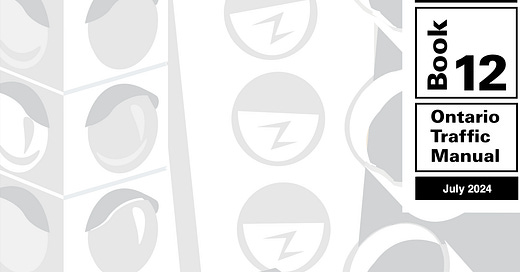The 2024 update to the Ontario Traffic Manual (OTM) Book 12 introduces new changes that municipalities and consultants should be aware of as they plan, design, and maintain traffic signal systems. While some jurisdictions have already taken steps that align with these revisions, others may find that key areas —particularly accessible signals, bicycle infrastructure, and connected vehicle readiness — require closer attention.
This post summarizes the most relevant updates from a practitioner’s standpoint and highlights specific areas that may require updates to designs, inspections, and operational procedures.
These highlights at a glance include:
Formalized maintenance intervals for APS and detection systems;
Introduction of the Ontario Capacity Analysis Method (OCAM) for left-turn justification;
New guidance on bicycle signals, crossrides, and dedicated bicycle phasing;
Leading Bicycle Intervals (LBIs) are now fully defined and recommended at high-conflict locations;
Expanded SPaT, MAP, and V2X guidance for connected vehicle integration;
Updates to signal timing assumptions, especially pedestrian walking speeds (i.e. initial 1.0 m/s);
New warrant justifications: 5A (collision analysis), 6A (pedestrian volume), 6B (pedestrian delay);
Clarified HTA references and administrative requirements for automated enforcement; and
Cybersecurity guidance linked to controller communication and CV data exchange.
Accessible Pedestrian Signals (APS): Design and Inspection Standards
OTM 12 now formalizes APS inspection intervals: every 6 and 12 months, including subsystem checks for audible features, pushbutton placement, and tactile arrows.
Municipalities should ensure:
Field staff and contractors are trained on AODA-compliant APS implementation;
CAD templates are updated to reflect APS design standards; and
Maintenance contractors are following the updated inspection timelines.
Bicycle Signals and Phasing: New Design Standards
OTM Book 12 (2024) has fully retired and integrated the content from OTM Book 12A (2018) – Bicycle Traffic Signals, incorporating it into a new, fully standardized Section 6. While Book 12A served as a dedicated reference for bicycle-specific signals and phasing, these guidelines are now embedded directly in the core manual, ensuring consistency across all aspects of signal design, from warranting through to operation.
Key updates and integrations include:
Consolidated standards for bicycle-specific signal displays, head placement, lens sizing, and mounting height;
Clear requirements for Leading Bicycle Intervals (LBI), bicycle-only phases, and shared phasing with pedestrians;
Updated criteria for when to implement bicycle phasing, based on volume, geometry, or known conflicts;
Expanded guidance on mid-block crossings, contraflow treatments, and intersection configurations;
Detailed specifications for detection, including passive vs. active methods, loop design, radar/video options, and pushbuttons; and
Emphasis on aligning signal designs with OTM Book 18 and HTA Regulation 626.
Municipalities should review and update their design templates to reflect this integrated framework. If your organization previously relied on Book 12A, now is the time to align with Book 12’s core standards to ensure compliance, consistency, and clarity.
Connected Vehicle Integration: SPaT, MAP, and V2X Readiness
Connected vehicle readiness is now directly addressed in Book 12, including protocols for SPaT (Signal Phase and Timing), MAP (intersection geometry), and V2X (vehicle-to-everything) data exchange. While some controllers already support these features, implementation will require:
Verifying controller firmware and hardware compatibility;
Enhancing cybersecurity for V2X data sharing and controller communications; and
Planning for future integration aligned with broader CAV (Connected and Automated Vehicles) or ITS (intelligent transportation system) policies.
Signal Timing and Phase Justification: OCAM and EB Analysis
Book 12 introduces the Ontario Capacity Analysis Method (OCAM) for left-turn phase justification and the Empirical Bayes (EB) method for collision-based warrants under Justification 5A. These are intended to modernize decision-making by:
Moving beyond basic volume thresholds to safety-based assessments;
Aligning signal warrant processes with contemporary analysis tools; and
Introducing clear methodology for pedestrian delay and volume under Justifications 6A and 6B.
Municipalities should review the updated justification and how these changes may impact signal approval workflows.
Legal References, AODA, and Enforcement Compliance
The updated OTM cross-references several HTA statutes and AODA regulations more explicitly. This includes correct references for red light camera notices and a legal basis for by-laws governing bicycle-specific signals.
Municipalities may wish to:
Review administrative processes for automated enforcement notices;
Coordinate with legal and risk departments on new by-law needs (e.g. crossrides); and
Confirm pedestrian features (e.g. APS, curb ramps) align with AODA expectations.
Maintenance Protocols and Inspection Schedules
Maintenance standards are now more prescriptive, requiring 6 and 12-month inspections across a range of systems:
Conflict monitors;
Portable signal systems;
Bicycle detection and APS; and
UPS and ancillary devices.
These updates are both compliance-driven and can help identify aging infrastructure before it becomes a safety concern.
Checklist: Where to Focus Your Review
To help practitioners prioritize their response to the 2024 OTM Book 12 update, here’s a focused list of potential review areas for consideration:
✅ Short-Term (0–12 Months)
Confirm APS designs meet AODA standards.
Update APS and detection maintenance schedules.
Review bicycle signal layout templates.
Train staff on APS and bicycle-specific phasing.
Audit HTA references on RLC/ASE notices.
🔄 Medium-Term (1–3 Years)
Review left-turn phasing using OCAM.
Identify high-conflict intersections for LBI or dedicated bike phases.
Validate bicycle detection coverage and signage.
Adopt Justification 5A/6A/6B in warrant reviews.
Update SOPs on signal re-approval and justification tracking.
🔧 Long-Term
Plan for SPaT, MAP, and V2X support in future signal projects.
Engage IT for controller cybersecurity readiness.
Evaluate the need for new by-laws governing bicycle-specific movements.
The 2024 OTM Book 12 update reflects the evolving expectations for inclusive, technology-ready, and safety-focused traffic signal systems. While some changes will require more significant investment or planning, others can be implemented quickly for immediate compliance and safety benefits. What priorities would benefit your municipality or clients most?





